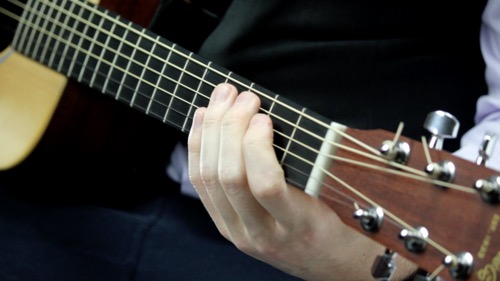吉他音程图

Hi. This is Hub Guitar.
Let's talk about learning the intervals on the guitar fretboard.
A lot of guitar players never take this step, and it's a shame because this is really key to understanding how the guitar works.
You probably already know what an interval is. It's the measurable distance between any two notes. For instance, this is one interval, and that is another interval. You also probably know of a few intervals already. You have your octave, which is a note of the same name that is higher up. You've also heard of half-steps, consisting of one fret, which is really the interval called a minor second. And whole-steps, consisting of two frets, would be the interval called a major second.
But actually, every distance between any two points has a specific name and a consistent relationship on the guitar that you can learn. If you can learn how to play and recognize all of them, it will really help unlock the fretboard.
You can do this between any two points at all, so you can just take this note, and this note, and ask yourself what the interval is. you can also give each interval a different name sometimes depending on whether you're thinking in terms of the bottom one going up, like is it a G going to C, or it's a C going down to G. For instance, the half-step here can be thought of as a minor-second if you're going up a half-step, but if you're going down a half-step it can be thought of as a major-seventh going down. because this would be the major seventh above, this would be the major seventh below. For now, we are just gonna think of them as a low note, and what the higher note is in relationship to the low note.
For now, we're gonna start just the fifth string and sixth strings.
So we'll play C on the fifth string and figure out what all the intervals in this neighbourhood are. So here is a C on the fifth string. I want to know that in relation to this note, what're all these notes in this neighbourhood. The best thing to do is to play a major scales and start there. For instance from C to E is a major third. From C to F is a perfect fourth. From C to G is a perfect fifth and so on. So we want to look at all of these other notes around this neighbourhood and then figure out what interval they would be. The C was root.
We can also do it at the VIIIth fret, and we'll have similar results.
This is very very useful for understanding chords, scales and arpeggios. In fact, when you get good enough at this, you can play a lot of patterns in real time just by using your head. Even if you haven't memorized the pattern, you can sort of calculate it if you can think quickly enough. And that's a powerful tool to have.
什么是音程?
如果你还不知道音程的定义的话,请先学习review how intervals work以后,再回来接下去的课程。
了解吉他音程
如果你想要知道吉他指板上面每一个音符之间的关系,最好学习吉他所有的音程。你可以在弹奏的过程中简单的归纳总结出你自己的音程 “表格” 或是 “图形”。
学习了解吉他指板有两种方法:第一种是,记住所有的音符,并且知道你要弹的是哪一个。第二种就是学习吉他音符之间的关系,知道你要利用的是哪一种关系。
大多数的人会选择第二种方法,也就是学习音符之间的关系。虽然知道每一个音符的位置是很重要的,但是深入了解它们的关系是更加有逻辑性的,因为乐器的布局有一定的规律。
一个最好的方法来视觉化这种关系就是,选择一个第五弦上的音符作为根音,学习所有和这个音可能相关的音程。
试想一下这个例子:下面这个音符,(“C”),是某个和弦或者音程的根音。我们想要写下所有可能的组合“图形”。

下图中,在根音和带问号的音之间,我们找到的是什么音程?

这两个音符是什么?根音是C,带问号的音是G。由于G是C大调音阶的第五个音符,所以我们说G是C的五度音。如果根音在A弦上的话,你可以在D弦的两品上找到一个纯五度。这一点是一直通用的。
如果你想知道这个音符是什么,你也可以试着在第五弦(根音所在的弦)上找相同的音,然后像之前一样的数音阶从而得知这个音到底是什么音。
现在你自己试试把第一个例子中的其他音都找出来。
根音在第六弦上

我们同样也可以把根音C移动到第六弦上。
大多数的音程和之前相同,请你用比把它们写下来,然后和之前的答案交叉检查一下。
练习
- 首先,写出大调音阶中出现的音程:2, 3, 4, 5, 6, 7, 8, 等等。
- 用高音调作为参考写出空白处的内容。比如,比五度低了半音的音调就是 ♭5 或叫 flatted fifth。
- 利用上面两个例子:随意选择两个音符,尝试根据根音快速的说出它们的音程,直到你说出全部的音符为止。目标是为了之后记起来的速度越来越快。
答案
注意:所有flatted音程可以enharmonicIn 12-tone equal temperament, a note is enharmonic if its spelling has changed. Since G♯ and A♭ are the same note in this system, G♯ can be referred to as the enharmonic spelling of A♭.ally地拼写出来;比如说,♭5 可以写成 #4。


本日目标
- 学习上面两个把位地吉他音程。
- 在第V品上随意选择一个音符开始;选择一个音程定位。
- 重复几次这个练习知道你能够快速地定位所有音程。
 As the creator of Hub Guitar, Grey has compiled hundreds of guitar lessons, written several books, and filmed hundreds of video lessons. He teaches private lessons in his Boston studio, as well as via video chat through TakeLessons.
As the creator of Hub Guitar, Grey has compiled hundreds of guitar lessons, written several books, and filmed hundreds of video lessons. He teaches private lessons in his Boston studio, as well as via video chat through TakeLessons.